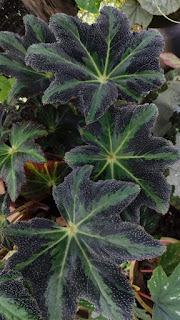Photo Credit to Dr Rabiatuadawiyah Kari
CHARACTERISTICS:
This particular type of hybrid have closer resembles to another famously known Begonia 'Chivalry' however I must say this particular one appears to be much grander, larger and much beautiful than the earlier one.
It does appear to have some resemblance with few different types of Star Shaped heracleifolia 'Nigricans' however newer hybrids have been introduced but without much proper introduction.
In most cases, Star Begonia often identified as a Gryphon Begonia due to the majestic look of the foliage display. Alternatively it's also known as Pegasus Begonia, all these variants and types are basically labelled as Begonia heracleifolia. these types often have a slight curvature - something like a swirl on the overall foliage structure - this particular one does not.
It is easily identified with the Star Shaped big sized foliage - very much behaves like a rhizome begonia which I would consider a hardy plant especially when the plant grows well and had already established itself. Another factor when it comes to these types - they are often 7 pointed Star Shaped Begonia.
These hybrids are very much in borderline with 2 different species - namely the Black Velvet Begonias together with this Gryphon Begonia types where these are of the larger version.
Other characteristics are very much the same when it comes to these furry begonia types.
Just to list few of their names for their close resembles:
GENERAL BEGONIA PLANT CARE:
Plant Care is very similar like most Rhizome Begonia Care & Cultivation Needs. This depends in different garden or indoor conditions - its all depending on getting the right balanced conditions.
Depending on the Begonia adaptation and its ability to handle hardy conditions - if the plant is stress it may drop all it's leaves before regeneration - hence more care is required to ensure the right balance of watering and humidity verse root and stem rot.
Medium:
Fast Draining - 1/3 Compost at the bottom layered with coconut chips and sand in between the rhizome root-ball.
Watering
Water only when the Medium is Dry
Water only when the Medium is Dry
Feeding
Foliar Fertilizer - Once a Week with 1/2 Dilution Strength.
Foliar Fertilizer - Once a Week with 1/2 Dilution Strength.
(Depending on what works best in your garden conditions - some gardeners use chicken/goat manure, coffee based fertilizer, organic fertilizer - test out and see on a trial basis to see what works best in your garden conditions)
Light
Place in Bright, Indirect Light - Shaded from direct hot sun areas - Ideal for Balcony Plants.
Do take note that this one truly hate too much water - the leaves may also change colors, especially turning pale green and the red and burgundy coloration faded. Do take note that if this happens - most likely the plant lifespan is numbered and the eventually leaf by leaf - they start dropping and the rhizome dried up or rotting and it is too late to safe the plant or rectify the problem.
Hence - do watch out on the overwatering part - the medium too play a big part on this, especially if it purchased with cocopeat planted with it - its more likely a dooms-day time clocking by the days for it to kaput. It is much better to take the risk to replant it to a new medium and allow the plant to grow through shock and recover and safe the plant - keeping it long term for years to go by then seeing it fall apart when the cocopeat dried up together with the root-ball.
Begonia Common Names and Images
Do click on the Link Above ☝
Here is the link where I had put together a list of all the begonias that I had come across.
A database of all the different types & their characteristics.
Please click on the link on the title above for the post.




















No comments:
Post a Comment